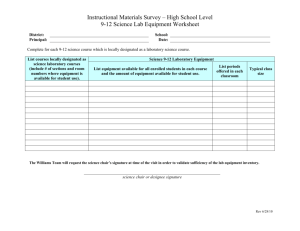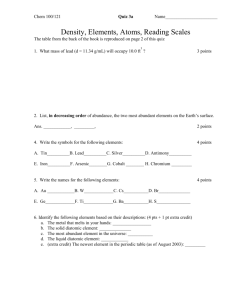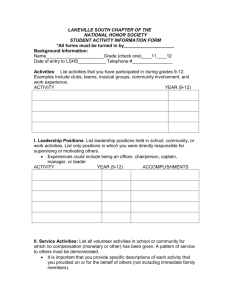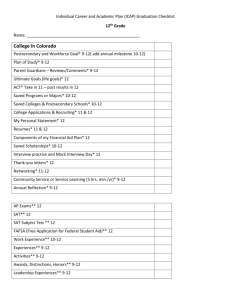CCR Biology - Chapter 5 Practice Quizzes
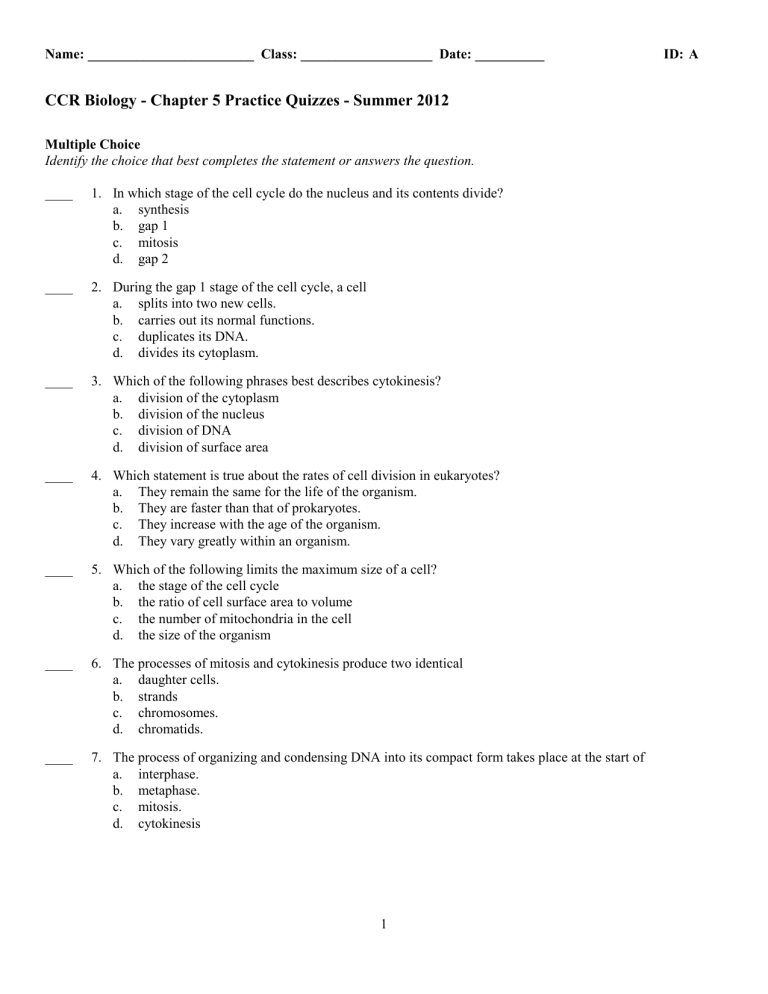
Name: ________________________ Class: ___________________ Date: __________
CCR Biology - Chapter 5 Practice Quizzes - Summer 2012
Multiple Choice
Identify the choice that best completes the statement or answers the question.
____ 1. In which stage of the cell cycle do the nucleus and its contents divide?
a.
synthesis b.
gap 1 c.
mitosis d.
gap 2
____ 2. During the gap 1 stage of the cell cycle, a cell a.
splits into two new cells.
b.
carries out its normal functions.
c.
duplicates its DNA.
d.
divides its cytoplasm.
____ 3. Which of the following phrases best describes cytokinesis?
a.
division of the cytoplasm b.
division of the nucleus c.
division of DNA d.
division of surface area
____ 4. Which statement is true about the rates of cell division in eukaryotes?
a.
They remain the same for the life of the organism.
b.
They are faster than that of prokaryotes.
c.
They increase with the age of the organism.
d.
They vary greatly within an organism.
____ 5. Which of the following limits the maximum size of a cell?
a.
the stage of the cell cycle b.
the ratio of cell surface area to volume c.
the number of mitochondria in the cell d.
the size of the organism
____ 6. The processes of mitosis and cytokinesis produce two identical a.
daughter cells.
b.
strands c.
chromosomes.
d.
chromatids.
____ 7. The process of organizing and condensing DNA into its compact form takes place at the start of a.
interphase.
b.
metaphase.
c.
mitosis.
d.
cytokinesis
ID: A
1
Name: ________________________ ID: A
____ 8. Which is the term for the group of proteins that organizes and condenses long strands of DNA into tight coils?
a.
telomeres b.
centromeres c.
chromatids d.
histones
____ 9. During which phase of mitosis do sister chromatids separate from each other?
a.
prophase b.
metaphase c.
anaphase d.
telophase
____ 10. Which of the following statements is true of cytokinesis?
a.
takes place in plant cells only b.
completes the cell cycle c.
organizes DNA d.
occurs during prophase
____ 11. Proteins that bind to cells and stimulate cell division are called a.
enzymes.
b.
kinases.
c.
growth factors.
d.
carcinogens.
____ 12. What is the term for the programmed death of cells?
a.
kinase b.
cyclin c.
carcinogen d.
apoptosis
____ 13. Two internal factors that are important in advancing the cell cycle are a.
kinases and cyclins.
b.
hormones and enzymes.
c.
phosphates and enzymes.
d.
proteins and platelets.
____ 14. Which phrase best describes cancer?
a.
absence of cyclins b.
multiple gene mutations c.
uncontrolled cell growth d.
presence of genetic defects
____ 15. Substances known to produce or promote cancer are called a.
carcinogens.
b.
kinases.
c.
cyclins.
d.
malignancies.
2
Name: ________________________
____ 16. The most common form of reproduction among prokaryotes is a.
sexual reproduction.
b.
binary fission.
c.
budding.
d.
fragmentation.
____ 17. What is the main difference between binary fission and mitosis?
a.
There is no DNA replication in binary fission.
b.
Two parents are required for mitotic reproduction.
c.
Binary fission occurs in single-celled organisms only.
d.
Mitosis takes place only in sexual reproduction.
____ 18. Which of the following statements is true of asexual reproduction?
a.
It produces few offspring.
b.
It produces genetically identical offspring.
c.
It produces genetic diversity.
d.
It produces offspring that are resistant to antibiotics.
____ 19. Starfish that reproduce by splitting into pieces are reproducing by a.
binary fission.
b.
vegetative reproduction.
c.
budding.
d.
fragmentation.
____ 20. Vegetative reproduction, budding, and fragmentation are examples of a.
asexual mitotic reproduction.
b.
reproduction through binary fission.
c.
prokaryotic colony formation.
d.
increased genetic variation.
____ 21. Which sequence shows the progression from least complex structure to most complex structure?
a.
cell
→
organ
→
tissue
→
organ system b.
cell
→
tissue
→
organ
→
organ system c.
organ system
→
tissue
→
organ
→
cell d.
organ system
→
organ
→
tissue
→
cell
____ 22. Which phrase best describes an organ system?
a.
group of specialized cells that forms organs b.
group of cells that differentiates at the same rate c.
group of tissues that performs a function d.
group of organs that work together
____ 23. Which of the following is a direct result of a normal cell's ability to express only certain genes?
a.
Cells can become totipotent.
b.
Cells can grow and reproduce.
c.
Cells can mutate and adapt.
d.
Cells can differentiate and specialize.
ID: A
3
Name: ________________________
____ 24. Stem cells are important to multicellular organisms because of their a.
capacity to differentiate.
b.
tendency to maintain homeostasis.
c.
potential to become totipotent.
d.
ability to relocate.
____ 25. Which type of stem cell can grow into any other cell type?
a.
somatic b.
multipotent c.
totipotent d.
pluripotent
ID: A
4
ID: A
CCR Biology - Chapter 5 Practice Quizzes - Summer 2012
Answer Section
MULTIPLE CHOICE
1. ANS: C PTS: 1
STA: KY 9-12.4.1.1 | KY 9-12.4.2.3
2. ANS: B
TOP: 5.1 Quiz
PTS: 1
REF: act0976aaf18007e0e6_80
TOP: 5.1 Quiz NOT: 978-0-618-78317-5
REF: act0976aaf18007e0e6_88
NOT: 978-0-618-78317-5
3. ANS: A PTS: 1
STA: KY 9-12.4.1.2 | KY 9-12.4.2.1
REF: act0976aaf18007e0e6_96
TOP: 5.1 Quiz NOT: 978-0-618-78317-5
4. ANS: D PTS: 1 REF: act0976aaf18007e0e6_104
STA: KY 9-12.4.1.1 | KY 9-12.4.1.2 | KY 9-12.4.2.1 | KY 9-12.4.2.2 | KY 9-12.6.1.5
TOP: 5.1 Quiz NOT: 978-0-618-78317-5
5. ANS: B
TOP: 5.1 Quiz
PTS: 1 REF: act0976aaf18007e0e6_112
NOT: 978-0-618-78317-5
6. ANS: A PTS: 1 REF: act0976aaf18007e0e8_80
STA: KY 9-12.4.1.1 | KY 9-12.4.2.2 | KY 9-12.4.2.3 | KY 9-12.6.1.5
TOP: 5.2 Quiz NOT: 978-0-618-78317-5
7. ANS: C PTS: 1
STA: KY 9-12.4.1.1 | KY 9-12.4.2.3
REF: act0976aaf18007e0e8_88
TOP: 5.2 Quiz NOT: 978-0-618-78317-5
8. ANS: D PTS: 1 REF: act0976aaf18007e0e8_96
STA: KY 9-12.4.1.2 | KY 9-12.4.1.3 | KY 9-12.4.1.7 | KY 9-12.4.2.1 | KY 9-12.4.2.6 | KY 9-12.6.1.7
TOP: 5.2 Quiz NOT: 978-0-618-78317-5
9. ANS: C PTS: 1
STA: KY 9-12.4.1.1 | KY 9-12.4.2.3
10. ANS: B PTS: 1
STA: KY 9-12.4.1.1 | KY 9-12.4.2.3
REF: act0976aaf18007e0e8_104
TOP: 5.2 Quiz NOT: 978-0-618-78317-5
REF: act0976aaf18007e0e8_112
TOP: 5.2 Quiz NOT: 978-0-618-78317-5
11. ANS: C PTS: 1 REF: act0976aaf18007e0ea_80
STA: KY 9-12.4.1.2 | KY 9-12.4.1.3 | KY 9-12.4.2.1 | KY 9-12.6.1.7
TOP: 5.3 Quiz NOT: 978-0-618-78317-5
12. ANS: D
TOP: 5.3 Quiz
13. ANS: A
TOP: 5.3 Quiz
PTS: 1 REF: act0976aaf18007e0ea_88
NOT: 978-0-618-78317-5
PTS: 1 REF: act0976aaf18007e0ea_96
NOT: 978-0-618-78317-5
14. ANS: C
TOP: 5.3 Quiz
15. ANS: A
TOP: 5.3 Quiz
16. ANS: B
TOP: 5.4 Quiz
17. ANS: C
TOP: 5.4 Quiz
PTS: 1
PTS: 1
PTS: 1 REF: act0976aaf18007e0ec_80
NOT: 978-0-618-78317-5
PTS: 1 REF: act0976aaf18007e0ec_88
NOT: 978-0-618-78317-5
18. ANS: B
STA: KY 9-12.4.2.6
PTS: 1
REF: act0976aaf18007e0ea_104
NOT: 978-0-618-78317-5
REF: act0976aaf18007e0ea_112
NOT: 978-0-618-78317-5
REF: act0976aaf18007e0ec_96
TOP: 5.4 Quiz NOT: 978-0-618-78317-5
1
19. ANS: D
TOP: 5.4 Quiz
20. ANS: A
TOP: 5.4 Quiz
PTS: 1 REF: act0976aaf18007e0ec_104
NOT: 978-0-618-78317-5
PTS: 1 REF: act0976aaf18007e0ec_112
NOT: 978-0-618-78317-5
21. ANS: B PTS: 1 REF: act0976aaf18007e0ee_80
STA: KY 9-12.4.1.1 | KY 9-12.4.1.2 | KY 9-12.4.2.1 | KY 9-12.4.2.2
TOP: 5.5 Quiz NOT: 978-0-618-78317-5
22. ANS: D
TOP: 5.5 Quiz
PTS: 1 REF: act0976aaf18007e0ee_88
NOT: 978-0-618-78317-5
23. ANS: D PTS: 1 REF: act0976aaf18007e0ee_96
STA: KY 9-12.4.1.1 | KY 9-12.4.1.2 | KY 9-12.4.2.1 | KY 9-12.4.2.2
TOP: 5.5 Quiz NOT: 978-0-618-78317-5
24. ANS: A
TOP: 5.5 Quiz
25. ANS: C
TOP: 5.5 Quiz
PTS: 1 REF: act0976aaf18007e0ee_104
NOT: 978-0-618-78317-5
PTS: 1 REF: act0976aaf18007e0ee_112
NOT: 978-0-618-78317-5
ID: A
2
